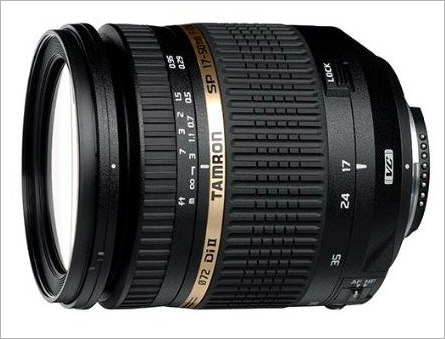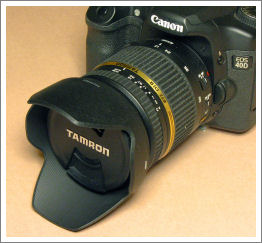

Tamron AF 17-50mm F/2.8 SP XR Di II VC Review
 |
The Tamron AF 17-50mm F/2.8 SP XR Di II VC is an optically stabilized version of Tamron's 17-50/2.8 Di II, though the two lenses do not share exactly the same optical design. The "VC" version has one less XR glass element, but one more LD and one more aspherical element. "VC" or Vibration Compensation is Tamron's equivalent to Canon's IS (Image Stabilization) and Nikon's VR (Vibration Reduction). A group of movable optical elements within the lens is used to compensate for camera movement via feed back from gyroscopic sensors.
.jpg)
The "Di II" in the name indicates the Tamron 17-50/2.8 Di II VC is designed for use only on crop sensor cameras. The image circle of the lens is large enough to cover an APS-C sized sensor, but not a full frame (36mm x 24mm) sensor. Tamron Di II lenses can be physically mounted on full frame DSLR bodies (including full frame Canon EOS DSLRs), but severe vignetting of the image will result, i.e. the sides and corners of the image will be black as shown in the images below.
.jpg)
On an APS-C crop sensor DSLR, a 17-50mm zoom gives the same angle of view as a 26-75mm would on a full frame Nikon or Sony camera, or a 27-80mm lens would on a Canon EOS DSLR. This is the focal length range most used in landscape and travel photography, as well as being useful for portrait work The relatively fast f2.8 aperture togther with the optical stabilization means that the Tamron 17-50/2.8 Di II VC makes a good choice for hand held low light photography.
Physical Description
The Tamron 17-50/2.8 SP XR Di-II VC barrel finish is slightly textured and the markings are painted onto the barrel (not engraved). The barrel is made of a plastic material but the lens mount is metal. Focal length markings for 17mm, 24mm, 35mm and 50mm are printed on the barrel. There is a distance scale but no DOF markings, as is normal these days for zoom lenses.
The rubberized zoom ring is about 3cm wide and is in the middlef the lens barrel. Approximately 90° of rotation are needed to go from 17mm to 50mm. The zoom ring can be locked with a small slide switch, but only at the 17mm position. Even unlocked there is no zoom creep, even when the lens is pointed straight up or down. Zooming is not internal and the lens extends from a length of about 9.5cm at 17mm to 12.5cm at the 50mm.
 The 1cm wide rubberized focusing ring is located towards the front of the lens. Close focus is 29cm and about a 50° rotation is required to go from 29cm to infinity focus. Note that the focus ring spins during autofocus, so you need to keep your fingers clear of it. To switch from autofocus to manual focus there is a small slide switch. Manual focus is smooth but essentially undamped.
The 1cm wide rubberized focusing ring is located towards the front of the lens. Close focus is 29cm and about a 50° rotation is required to go from 29cm to infinity focus. Note that the focus ring spins during autofocus, so you need to keep your fingers clear of it. To switch from autofocus to manual focus there is a small slide switch. Manual focus is smooth but essentially undamped.
VC (Vibration Control) is engaged via a small slide switch which is located next to the AF/MF switch on the side of the lens. There is only one mode which stabilizes both horizontal and vertical motion (pitch and yaw in technical terms).
The front element of the lens does not rotate during either zooming or focusing (focusing is internal), which makes the use of a polarizing filter more convenient.
A hood (petal style) which mounts on the lens using a bayonet fitting is supplied with the lens. The front of the lens is threaded for 72mm diameter filters and the lens cap is a "center squeeze" design which makes it easier to remove and replace with the lens hood mounted.
Tamron AF 17-50mm F/2.8 SP XR Di II VC Specifications
NEXT: Part II - Optical Performance
